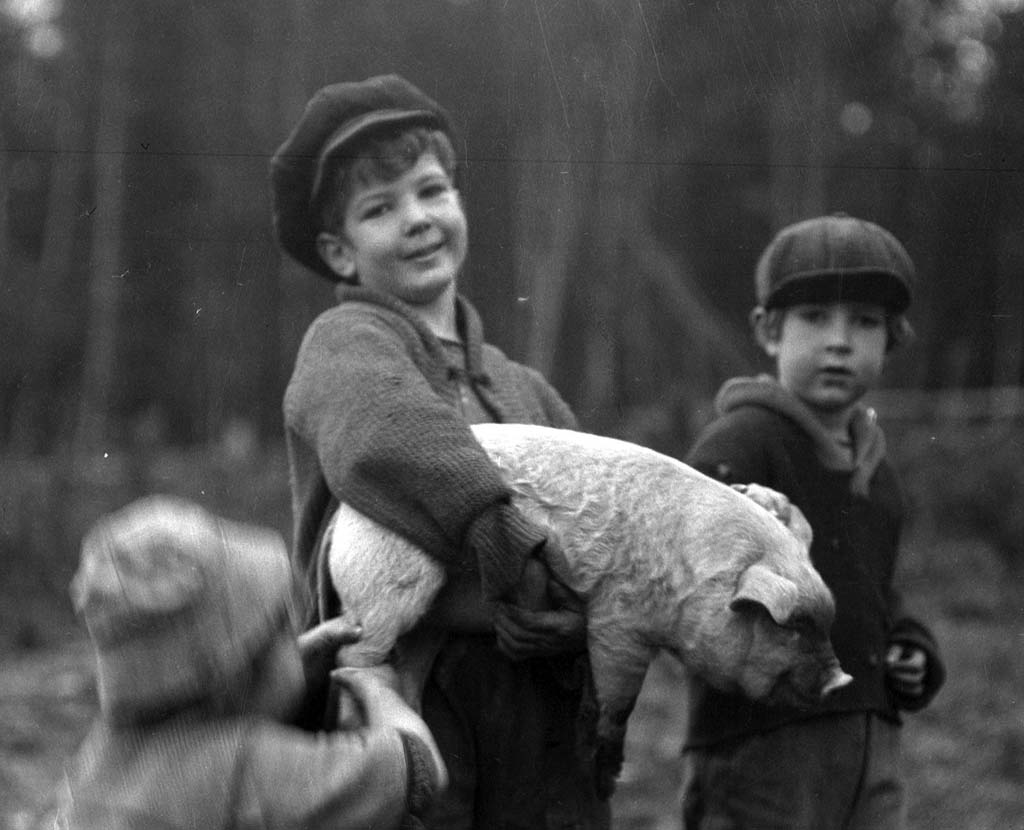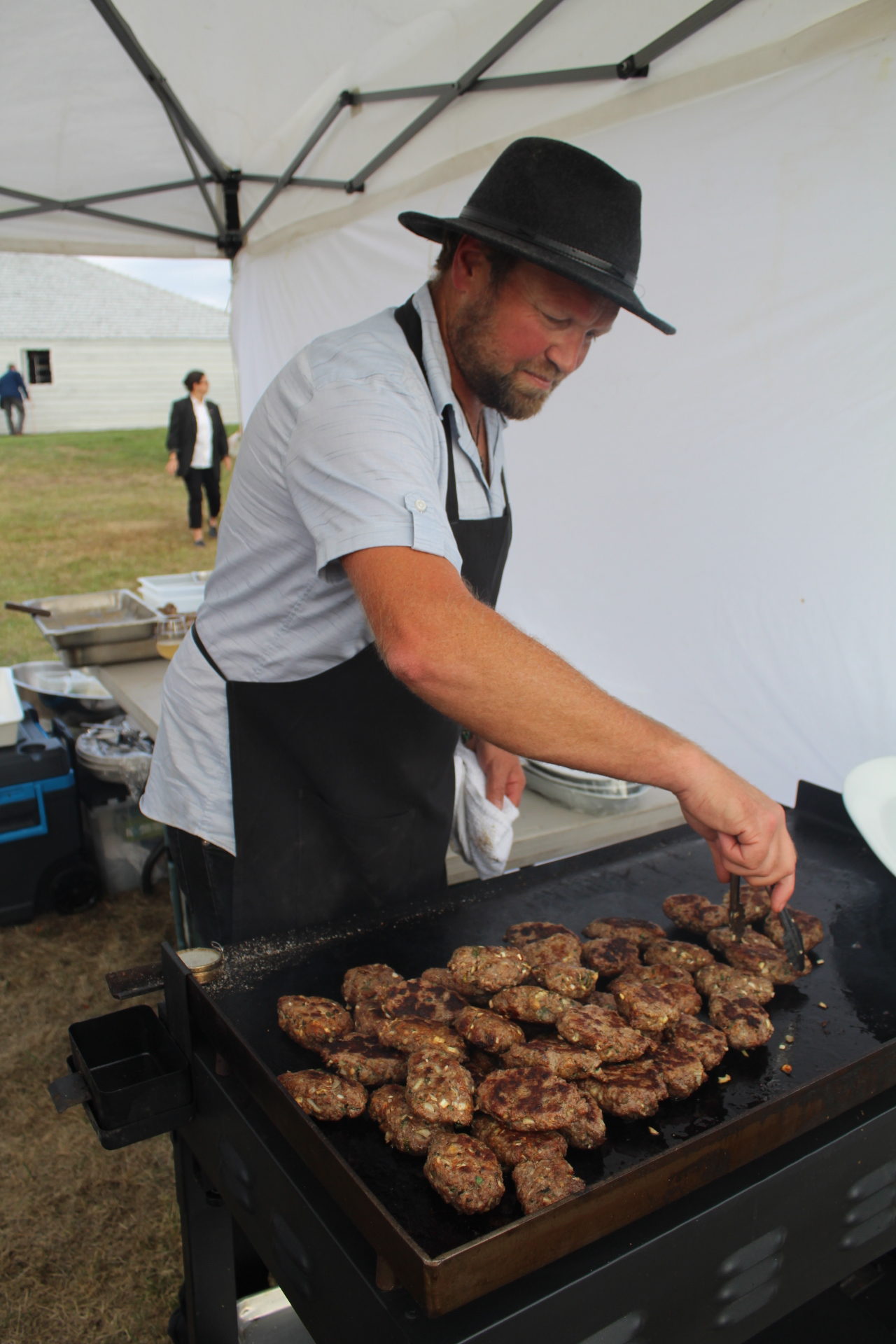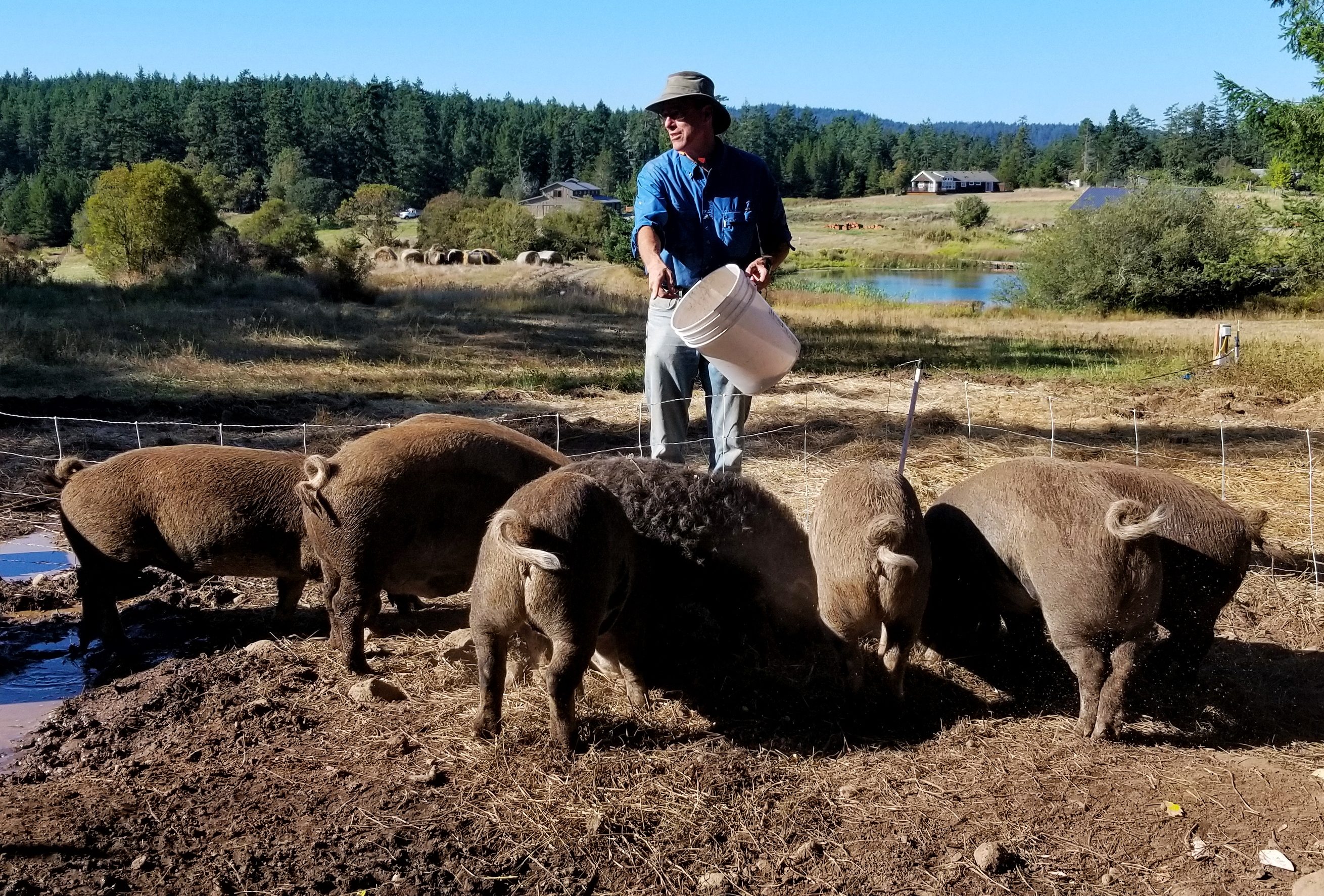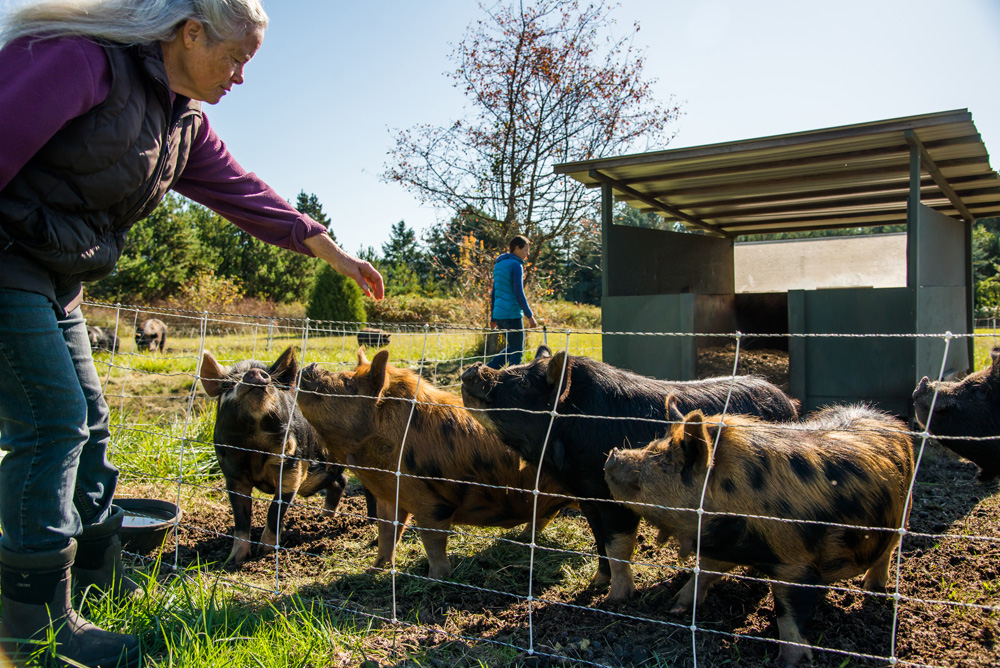The venerated pig is a microcosm of the cycle of food, farmers, and the future of sustainable farming in the Islands

With a history that includes a war named after the porcine species, the San Juans have a love affair with pork. And who wouldn’t? Because…bacon!
But just as the simple hog revealed a complex conflict that took years to resolve, behind the pork on our plates is a cycle of complex factors that bring this piggy to market.
As farmers and chefs have defined “island cuisine” over the past few decades, that meant raising more specialized products for an increasingly discerning market. In 2009, John Steward of Maple Rock Farm ordered his first Mangalitsa pigs from Heath Putnam of Wooly Pigs in Eastern Washington.
Doe Bay Cafe, long a vegetarian Mecca in the islands, added meat to the menu in 2017, with a focus on meat raised in the San Juans in a humane and sustainable manner. Chef Jon Chapelle and his crew create succulent tidbits such as Mangalitsa lardo.

The Mangalitsa is a star in the gourmet world, but not the only one that shines. On San Juan Island, farm consultant Warwick Hubber, who calls himself a hobby pig farmer and charcutier, raises Kune Kune and other breeds, hoping to create a truly “island grown” pork.
When I asked him whether what farmers feed their animals really contributes to the quality of the pork, his reply draws on a long history of iconic pork products:
“It does according to the hog farmers of the Spanish “Dehesa” (or oak forests), where the revered Iberico pigs are raised in honor of what they are fed (acorns from the oak trees),” says Hubber – known to most as Wocka. “The same goes for the pigs of Parma, Italy, where the much desired Proscuitto ham comes from.”
“And yes, I believe that what we feed our pigs makes a big difference to not only the flavor of our pork, but also in providing a signature product that is unique and distinguishable to place. I believe that to call island pork, “Island Pork” the animal should be raised on, or fed cereals, nuts and grains also grown on the island, on the lands for which we identify and label our final product.”
When we think of farming as a cycle that moves through the year, the process of developing high-quality food products that have a sense of the place they are grown, is a cycle as well, and a long process of change and growth.
“We’re soil first, water-friendly, and compassionate to our animals,” says Angie. All their meat is harvested low stress on the farm by the San Juan Islands’ unique regional USDA harvesting co-op, hung for maximum flavor and tenderness.
The Shephards currently raise and finish 30 Berkshire-Mangalitsa cross hogs a year, purchased from a family farm on Whidbey Island. They are raised outside in electric fences moving frequently throughout the year. This helps compost and clear shrubs and weeds from areas that are then seeded for pasture. They are fed organic hog grower milled in nearby Conway and then finished for the last month on fruit, local Whidbey Island barley soaked in milk and hazelnuts from a family orchard in Oregon.

Their meat can be delivered whole and fresh, or cut and wrapped to order fresh or frozen. Some of their buyers include both San Juan and Orcas Co-Op, The Willows on Lummi Island, Coho, Friday Harbor House, San Juan Island Country Club, Market Chef, Orcas and San Juan School Districts, Deb Nolan Island Cooking Company, Rene Beecham and other local caterers and numerous private individuals.
Although many farmers don’t yet have the resources to grow their own feed, some are experimenting with different options, including using the best organic feed from Eastern Washington, or hazelnuts from Oregon. And many chefs try to use the whole hog to create a new “nose-to-tail” cuisine in high-end establishments and small chef-owned bistros, and the awareness of the cycles of all aspects of raising an animal is following suit.
Maybe that’s why they call it “Slow Food” – these things take time.
Chefs throughout the islands, such as Chef Nick Coffey at Ursa Minor on Lopez and Friday Harbor House Chef Jason Aldous on San Juan have been working with Mangalitsa, Kune Kune crosses, Berkshire and other specialty breeds raised on the islands or in Skagit Valley.
Aldous has been researching a new relationship with Blacktail Bass & Beef.
“These pigs have some of the most incredible tasting meat and fat and are being raised in an amazing environment by farmers who care about what they are doing,” he says. “As their droves of hogs and flocks of lamb grow, we hope to feature them more regularly.”

Coffey currently buys pork from David and Robin Gibson at Two Sheds Farm. Also, one of the cooks at Ursa Minor, John Shaw, raises pigs on Lopez Island Farm, owned by Bruce Dunlop. They both grow Kune Kune crosses, which seem to be the most popular heritage breed on the island. Coffey saves scraps from the kitchen for them all summer, then grills and braises some cuts for the menu in the fall, as well as curing a lot of this succulent meat.
From feeding the pigs scraps from local vegetables used in their kitchen, to using as much of the animal as possible, Coffey tries to close the circle to keep the process as “island-grown” as possible.
“Coppa, culatello, hams, bacon, pancetta—you name it, we cure and hang it ourselves over the winter months. The breed allows for great ratio of fat to lean. In our case a great ratio is probably more fat than usual,” says Coffey. “(These pigs) are bit smaller which helps as we butcher them ourselves in our small kitchen.”
Hubber traces this ever-shifting and growing process—from finding the right breed, to sustainable farming methods to grow the best feed, to finding a market that will pay what this delicacy is worth, building farmer-chef relationships, to the quality of the slaughter, artisan butchery and handling in the kitchen, making the product available to home cooks at an affordable price, the challenge of finding low-impact packaging, and educating the consumer—the diverse factors influencing this cycle shows how complex our food system is.

“It is possible to farm pigs sustainably,” he says. “There are many farmers around the world who are farming using pragmatic and sustainable farming techniques that not only produce amazing and uniquely flavored products which not only give the product identity and a sense of place, but also work to develop the land and enhance the surrounding environment.”
Hubber sees pigs as a useful part of the process of maintaining a sustainable farm. “Pigs are versatile animals, and can be used to break up and cultivate land for the planting of legume and cereal crops,” he says, “which could in rotation, generate farm feed for the very same animals, eating and eradicating invasive plants and unground pests in the process as well as fertilizing the ground as they root the top layer of soils.”
“There needs to be a balance,” he says, between “the right breed of pigs selected for specific purposes on the farm, the right number of animals for the land to sustain, using local seasonal crops and excess orchard fruits can all supplement feed input.”

As farmers grow businesses to create a market, or respond to a market that wants “local” products, Hubber believes “we need to think and operate in the most sustainable way we can,” he says, “supporting and uplifting our entire farming community.”
Whatever point in the cycle can be touched, influenced or changed towards a more local, higher quality product—from breed to feed, butchery and cookery—the closer we are to our food, and the more sustainable, healthful and delicious our food system can become.
—Shannon Borg
